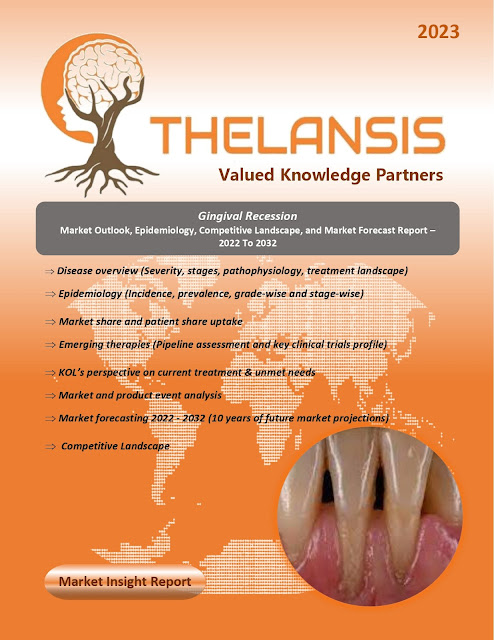Gingival Recession – Market Outlook, Epidemiology, Competitive Landscape, and Market Forecast Report – 2022 To 2032
Gingival recession, also known as soft tissue recession, is characterized by the displacement of the gingival margin below the cementoenamel junction (CEJ) of a tooth or the platform of a dental implant. This condition involves the loss of various periodontal tissues, including gingiva, periodontal ligament, root cementum, and bone at dental sites, and the loss of mucosa and bone around dental implants. The underlying causes of gingival recession encompass a range of factors, such as inflammatory periodontal diseases, trauma resulting from aggressive oral hygiene practices, recurrent inflammation due to bone dehiscence or fenestration beneath the gingiva, repeated inflammation linked to poorly fitting dental restorations, orthodontic-induced tooth movement through the labial bone plate, viral-induced ulceration of the gingival margin, cytotoxic drug-induced ulceration, benign familial neutropenia, traumatic injuries to the gingival margin, and compromised blood supply to the gingiva. Signs and symptoms that may indicate the presence of gingival recession include tooth mobility heightened tooth sensitivity characterized by short and intense pain, apparent elongation of teeth due to receding gums, visible exposure of tooth roots, formation of notches at the gum line of affected teeth, alterations in tooth color attributed to the differing shades between enamel and cementum, perception of increased spacing between teeth due to reduced gum coverage, and occurrence of cavities beneath the gum line. Additionally, gingival recession elevates the susceptibility to root surface caries development. Gingival recession is also commonly observed in pediatric populations. Several factors contribute to the predisposition of patients to developing gingival recession, including the presence of a narrow band of attached or keratinized gingiva, alveolar bony dehiscence, trauma from toothbrushing, prominent teeth, constraining frenum attachment, soft tissue interference from opposing occlusion, orthodontic tooth movement, utilization of impression techniques involving subgingival tissue retraction, oral habits, periodontitis, pseudo recession (extrusion of teeth), and intraoral piercings like tongue piercings. Numerous classification systems have been introduced to categorize gingival recession. Miller's classification system is the most widely adopted. Nevertheless, many cases cannot be effectively categorized based on the criteria of standard classification systems. An alternative classification system proposed by Kumar & Masamatti offers a comprehensive representation of recession defects and accommodates cases that cannot be classified using existing systems. Predominantly employed methods for treating gingival recession defects encompass pedicle flap surgical techniques, such as coronally advanced or rotational flaps.
·
It was estimated that over 20 million
individuals in the United States are affected by this condition.
Thelansis’s “Gingival Recession Market
Outlook, Epidemiology, Competitive Landscape, and Market Forecast Report – 2022
To 2032" covers disease overview, epidemiology, drug utilization,
prescription share analysis, competitive landscape, clinical practice,
regulatory landscape, patient share, market uptake, market forecast, and key
market insights under the potential Gingival Recession treatment modalities
options for eight major markets (USA, Germany, France, Italy, Spain, UK, Japan,
and China).
KOLs insights
of Gingival Recession across 8 MM market from the centre of Excellence/ Public/
Private hospitals participated in the study. Insights around current treatment
landscape, epidemiology, clinical characteristics, future treatment paradigm,
and Unmet needs.
Gingival Recession Market Forecast Patient
Based Forecast Model (MS. Excel Based Automated Dashboard), which Data Inputs
with sourcing, Market Event, and Product Event, Country specific Forecast
Model, Market uptake and patient share uptake, Attribute Analysis, Analog
Analysis, Disease burden, and pricing scenario, Summary, and Insights.
Thelansis Competitive Intelligence (CI) practice
has been established based on a deep understanding of the pharma/biotech
business environment to provide an optimized support system to all levels of
the decision-making process. It enables business leaders in forward-thinking
and proactive decision-making. Thelansis supports scientific and commercial
teams in seamless CI support by creating an AI/ ML-based technology-driven
platform that manages the data flow from primary and secondary sources.




Comments
Post a Comment